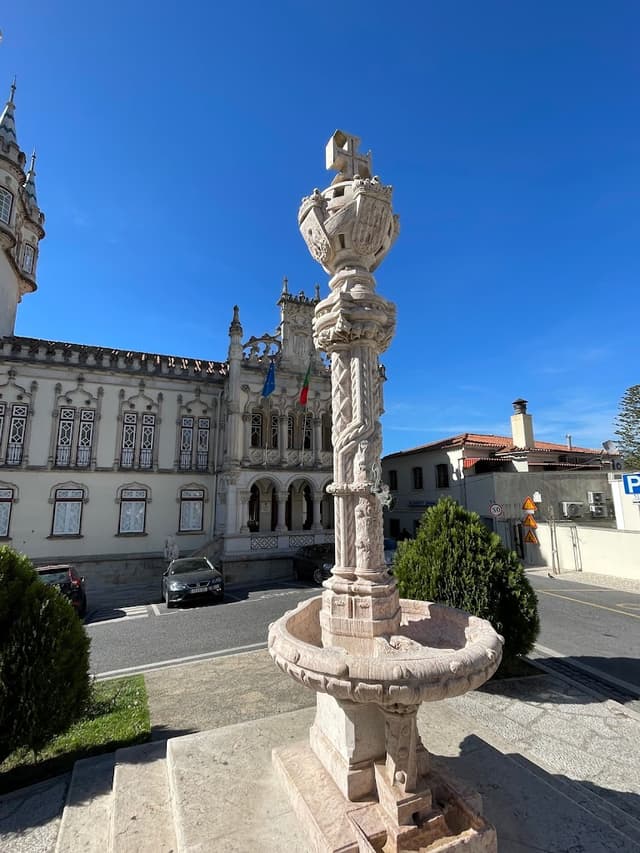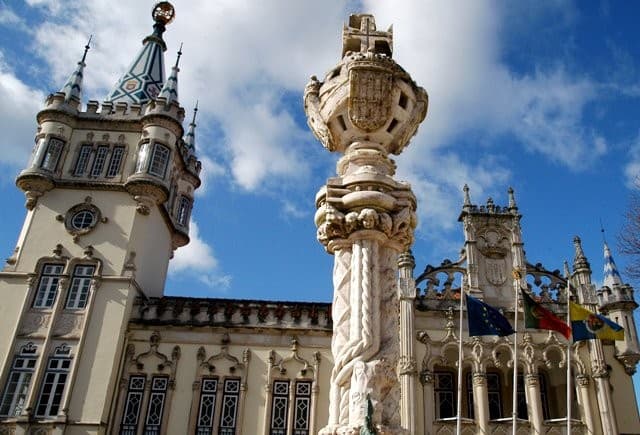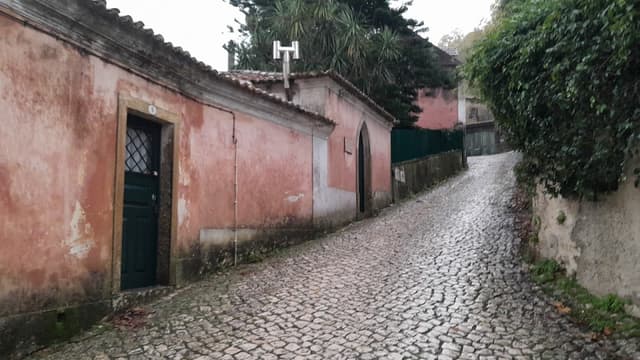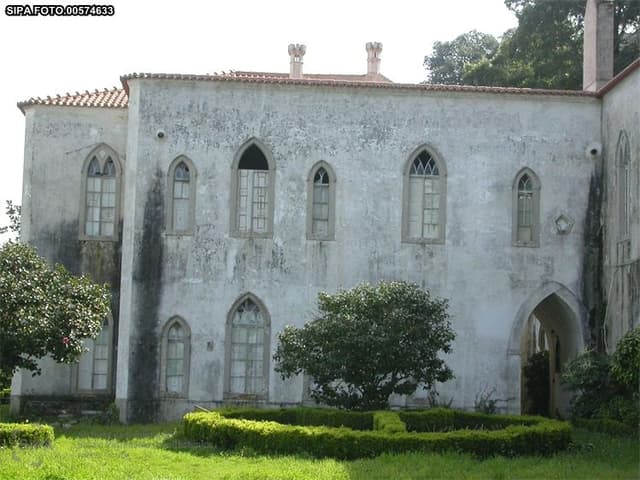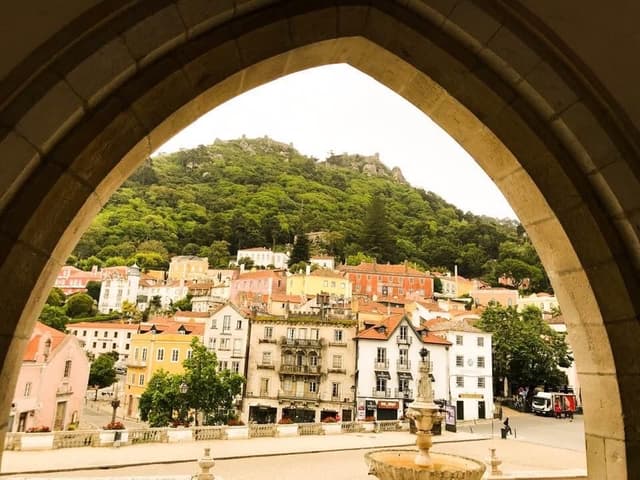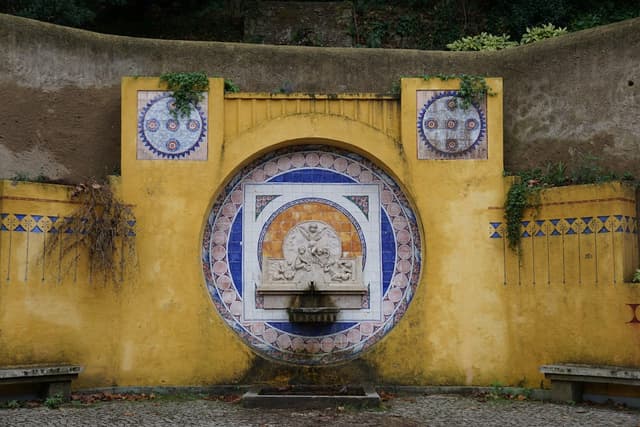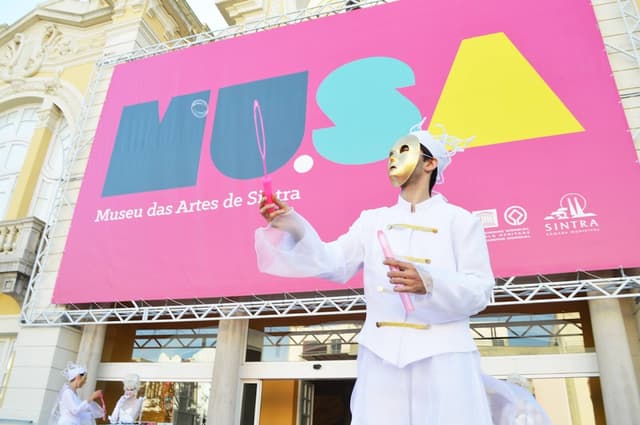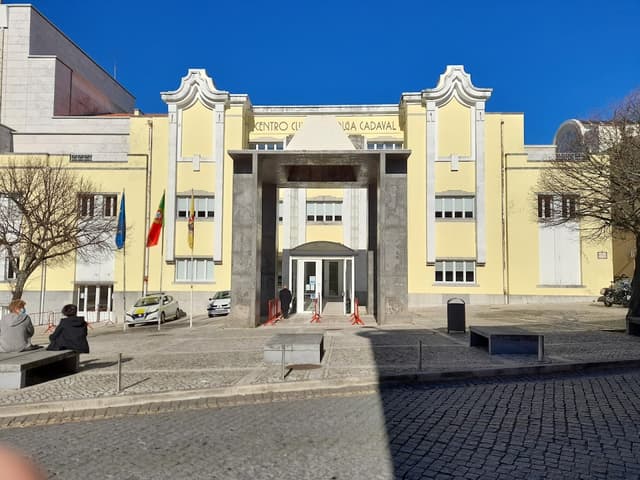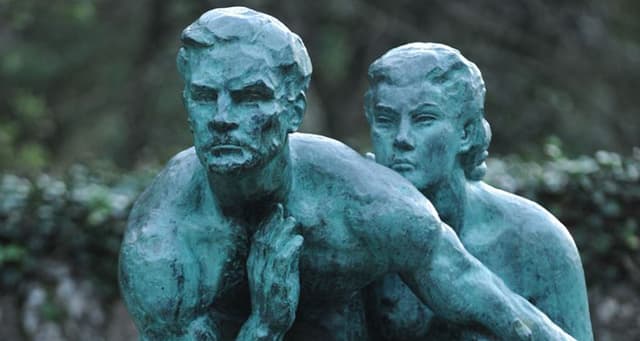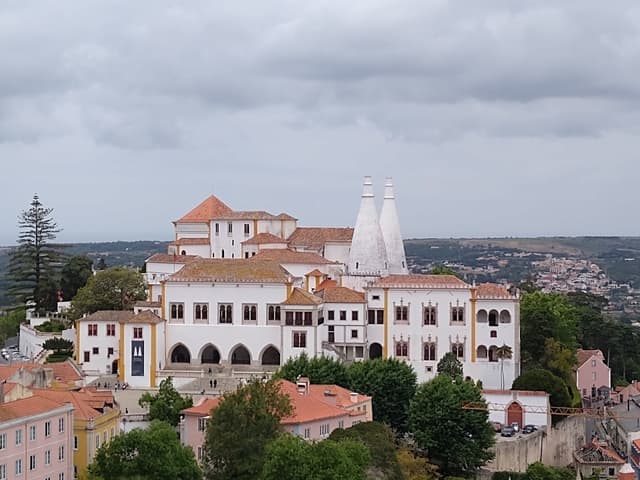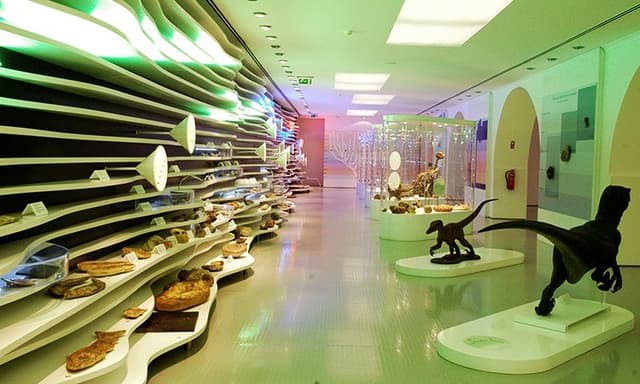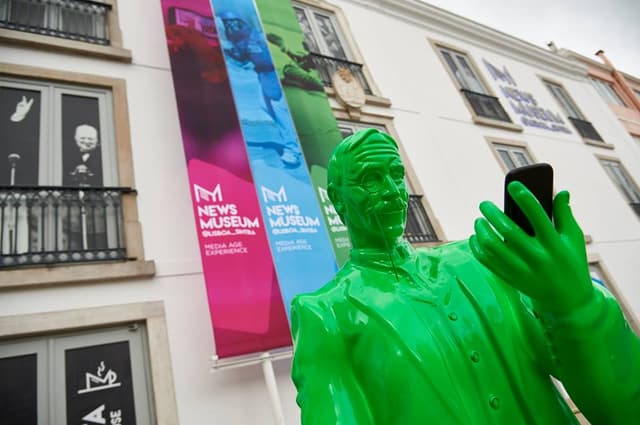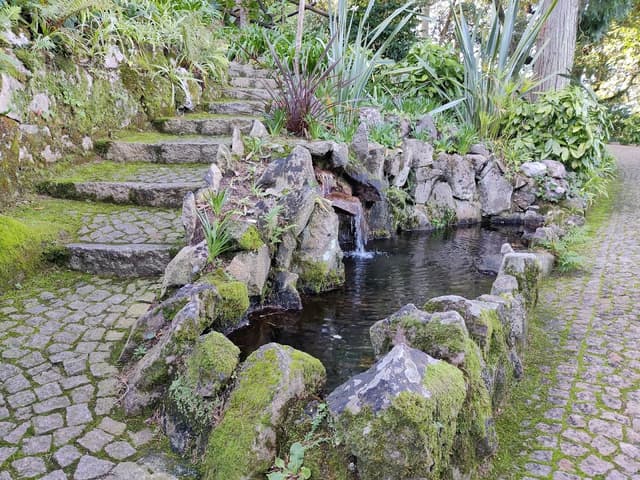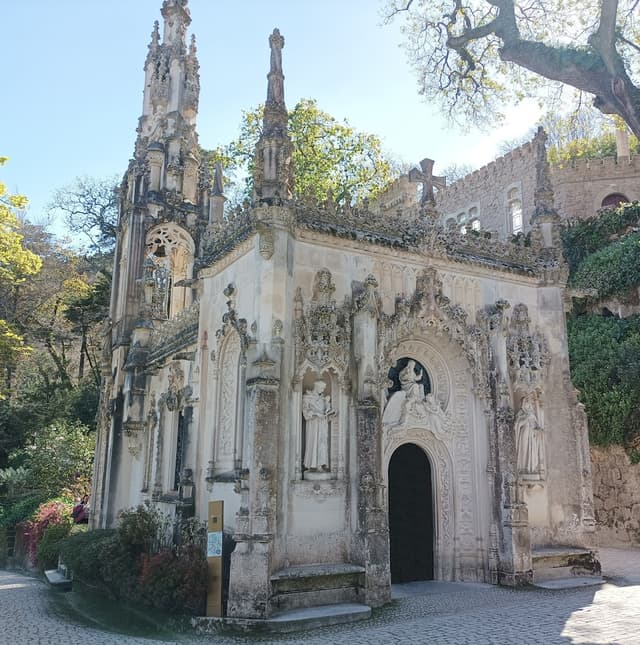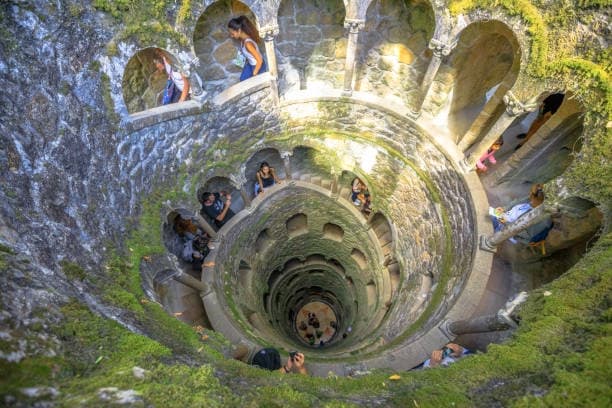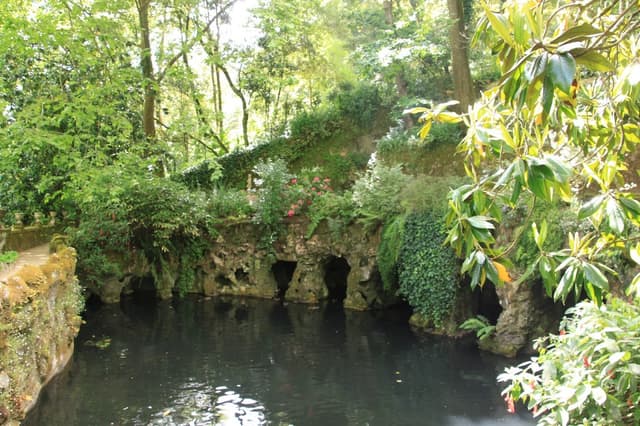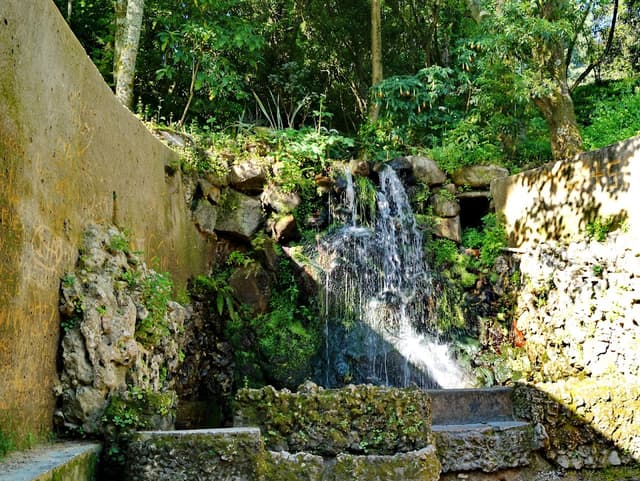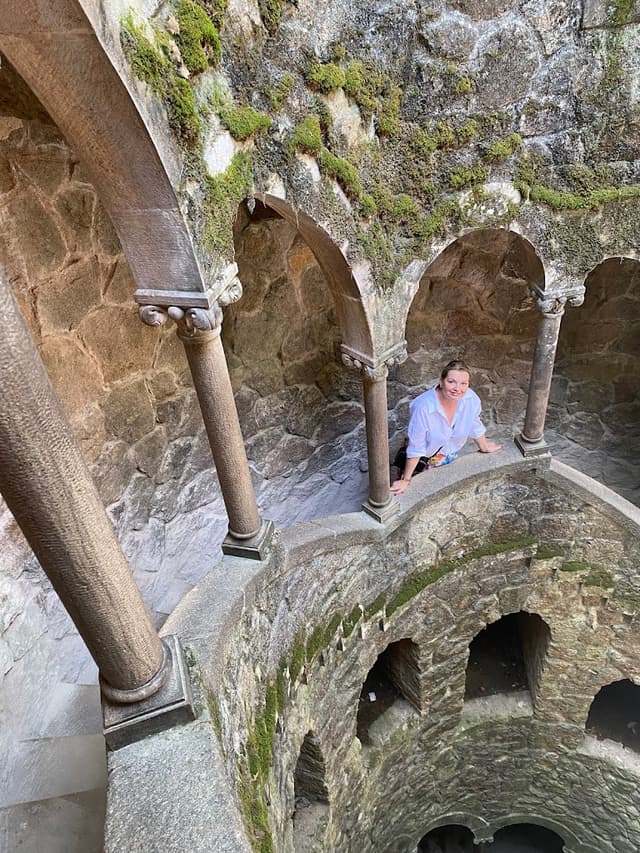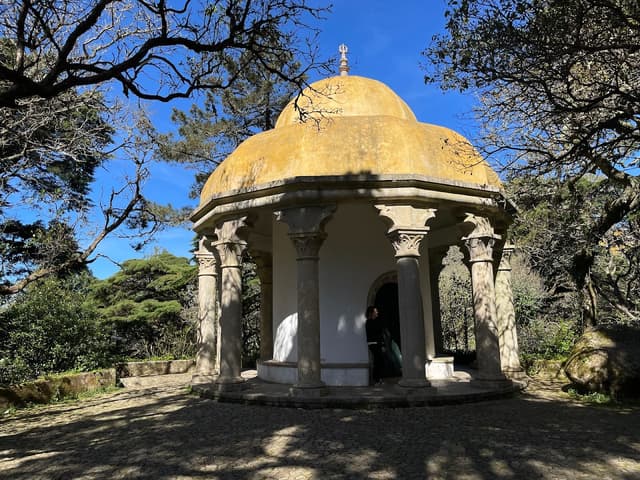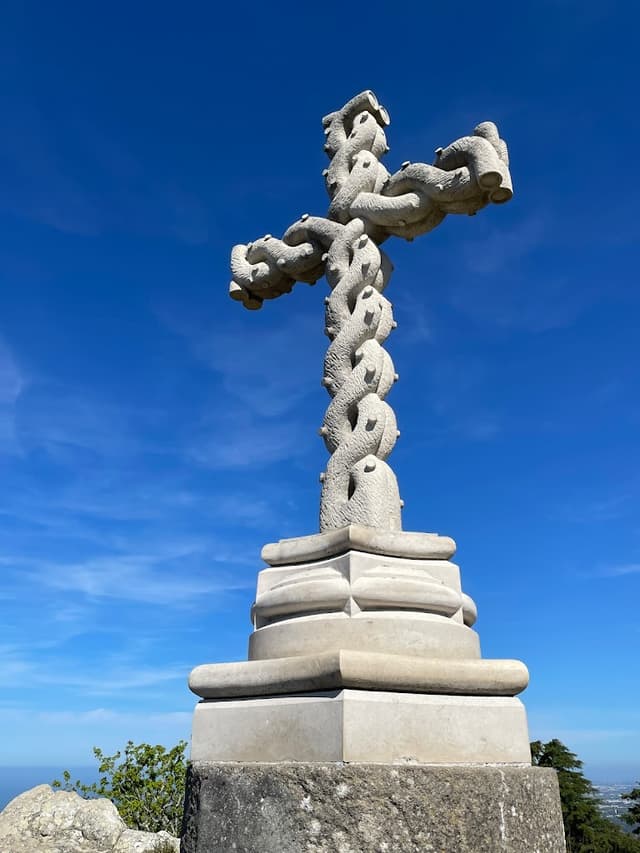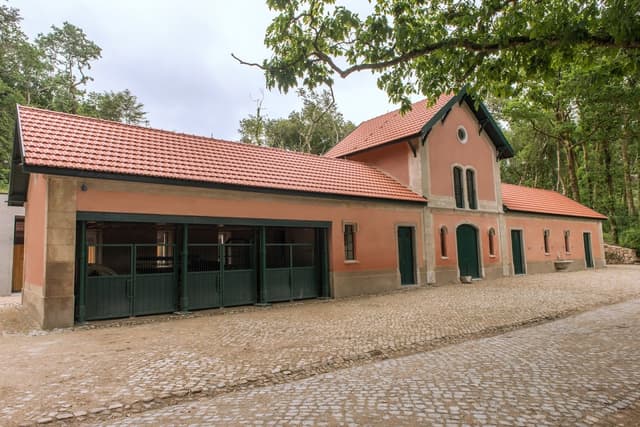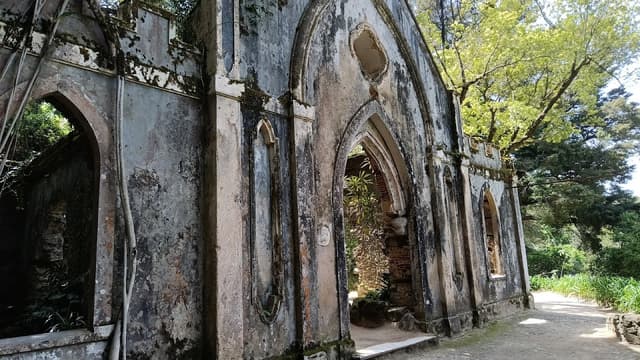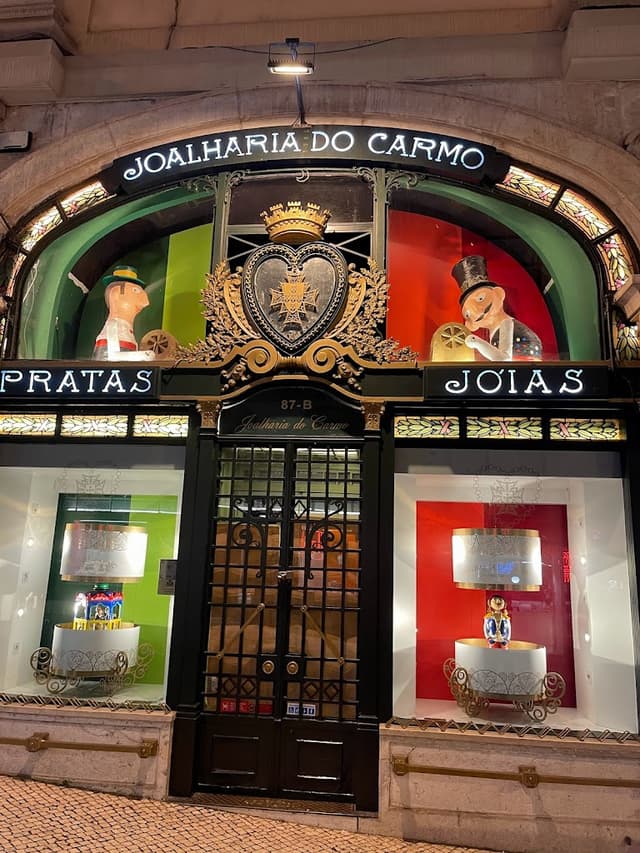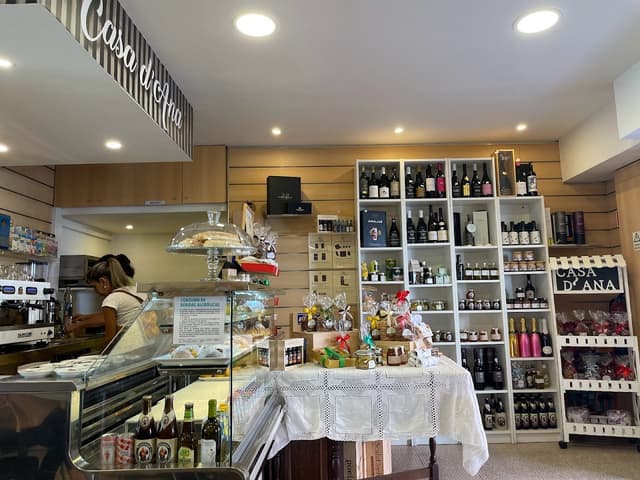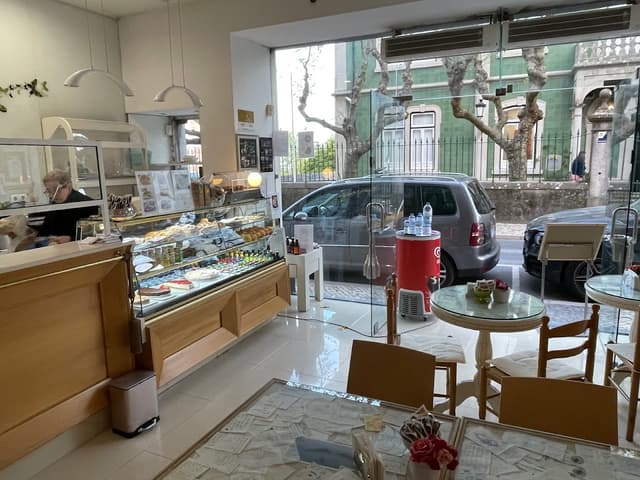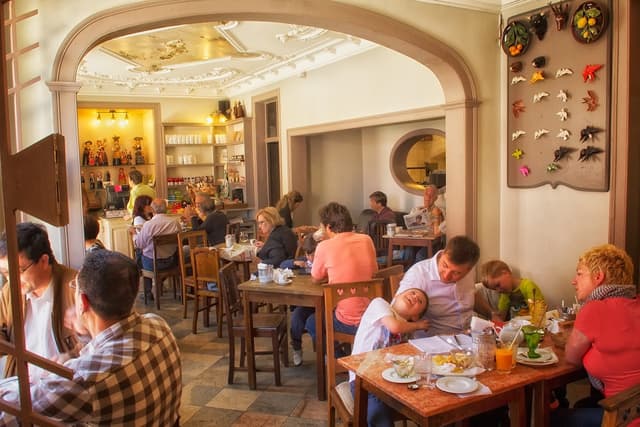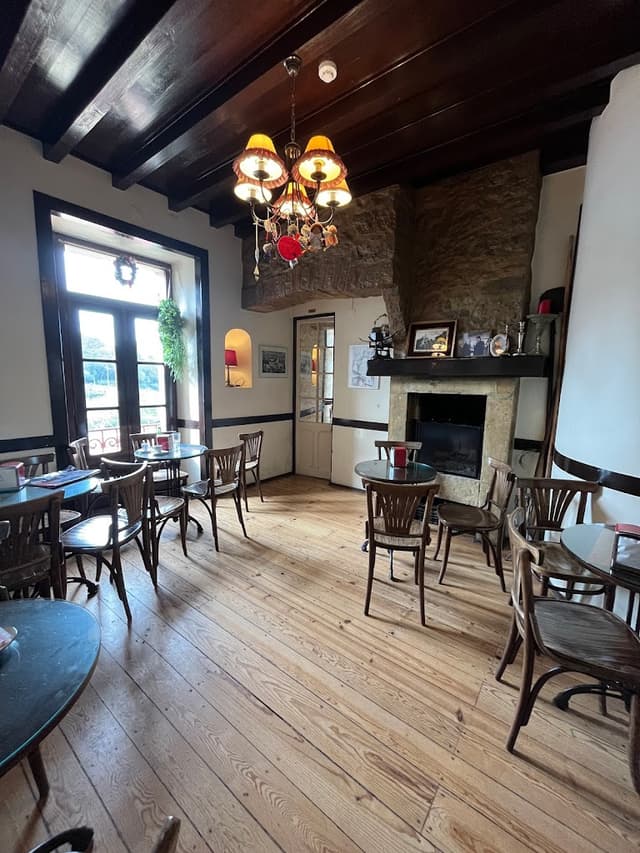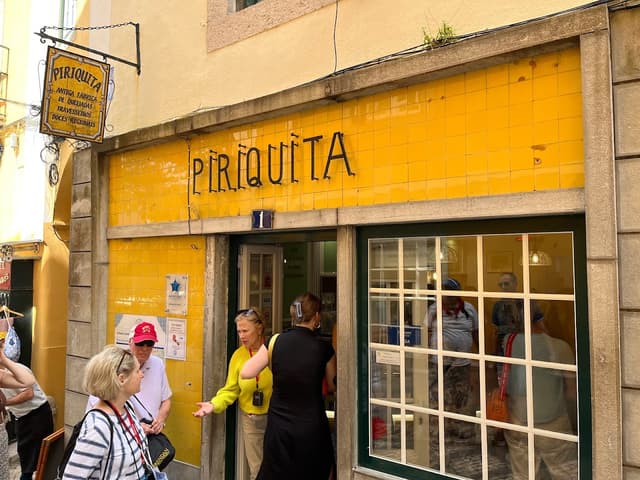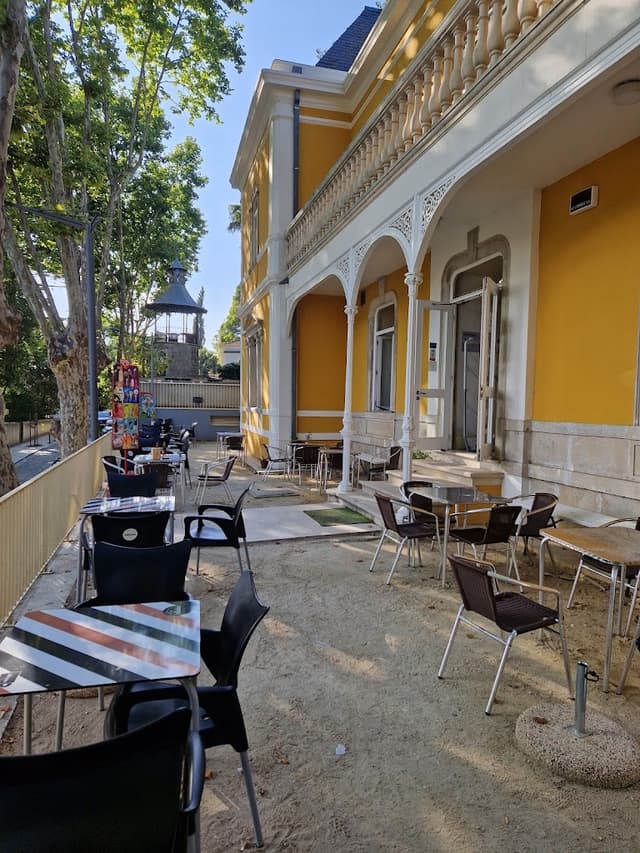A bit of context
Steeped in history and mysticism, Sintra, Portugal, has captivated hearts for centuries. Once a royal sanctuary, this charming town nestled in the foothills of the Sintra Mountains just outside Lisbon, continues to weave its magic. Founded in the 11th century by the Moors, Sintra's name itself has Arabic origins, hinting at its early cultural influences.
Royal favor cemented Sintra's allure. Portuguese monarchs sought refuge here, building extravagant palaces that still grace the landscape. The Pena National Palace, a vibrant architectural mashup perched on a hilltop, is a dazzling testament to this era. Winding cobbled streets lined with colorful houses lead to the Moorish Castle, offering panoramic vistas and whispers of a bygone era.
Beyond the historical intrigue, Sintra boasts a refreshingly mild climate and an otherworldly beauty. Dense forests cloak the Sintra Mountains, while hidden waterfalls and exotic gardens, like the mystical Quinta da Regaleira, create a sense of discovery and wonder. Sintra is a place where time seems to slow, inviting visitors to get lost in its timeless charm.
How to get there
Reaching Sintra from Lisbon is a breeze. Frequent trains depart from the historic Rossio Station, transporting you on a scenic journey through the Portuguese countryside in under an hour. For a seamless travel experience, consider purchasing a Lisboa Card. This handy pass grants access to Lisbon's public transportation network, including the train to Sintra, making exploration a breeze.
Alternatively, if you prefer a more flexible pace, express buses from Lisbon's Sete Rios bus terminal zip you to Sintra in around 25 minutes. For the adventurous, car rentals are also an option, allowing you to explore Sintra at your own rhythm and potentially venture further into the surrounding natural beauty. No matter your chosen mode of transport, prepare to be swept away by Sintra's magic.
How to move around
Sintra's magic unfolds at a delightfully walkable pace. Unlike sprawling cities, Sintra's heart, concentrated around the magnificent Pena National Palace, is a pedestrian paradise. Cobblestone streets lined with vibrant houses and charming cafes weave through the town, inviting you to lose yourself in the relaxed atmosphere. Most historical attractions, including the Moorish Castle and the whimsical Quinta da Regaleira, are all within easy reach, allowing you to discover hidden squares and stumble upon delightful surprises around every corner.
However, for those yearning to explore Sintra's wider embrace or seeking a respite from the afternoon sun, the town offers a convenient public transportation system. Local buses operated by Scotturb connect the town center with outlying palaces and gardens, like the Monserrate Palace and Seteais Palace. Simple-to-use ticket machines and informative stops make navigating the system effortless.
For the eco-traveler, Sintra boasts a haven of verdant beauty. Bicycle rentals are readily available, allowing you to explore the foothills and soak in the fresh mountain air at your own pace. Alternatively, hop on a tuk-tuk, a vibrant and colorful mode of transportation that adds a touch of whimsy to your exploration. These zippy vehicles not only navigate the charming streets but can also venture further afield, revealing hidden waterfalls and secret pathways.tunesharemore_vert
What to see
I´ll divide this guide in different interest sections, trying to keep up with a logical walking trail - from architecture to churches, museums and parks, ending with suggestions for coffee shops, restaurantes and sweets.
Old Town
Architecture, streets and squares
Pelourinho de Sintra
@pedralexpereira
The Pelourinho de Sintra is a pillory located in the civil parish of Sintra (São Pedro de Penaferrim), in the municipality of Sintra, in the Portuguese district of Lisbon.
The pillory is a stone column, approximately 4 meters tall, that was erected in the 16th century. The column is topped by a capital with four faces, each of which is decorated with a different symbol. The symbols represent the four traditional powers of justice: the sword, the scales, the crown, and the scepter.
The Pelourinho de Sintra is a classified as a National Monument of Portugal.

Details
Town Hall
@pedralexpereira
The Câmara Municipal de Sintra (Sintra Town Hall) is a building located in the civil parish of Sintra (Santa Maria e São Miguel), in the municipality of Sintra, in the Portuguese district of Lisbon.
The building was built in the 19th century and is a fine example of neoclassical architecture. The facade of the building is decorated with a number of statues and reliefs, including a statue of King Sebastian I of Portugal.
The Câmara Municipal de Sintra is the seat of the local government of Sintra. The building houses the offices of the mayor, the councilors, and the various departments of the municipal government.

Details
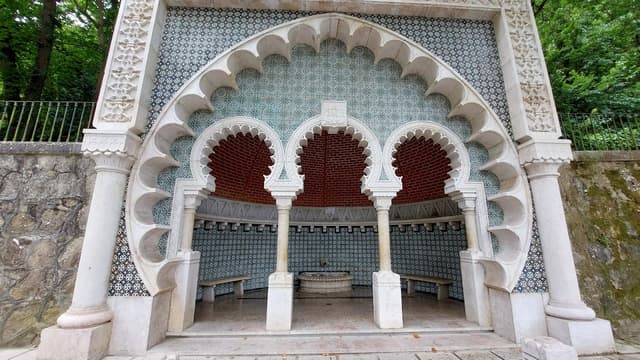
Fonte Mourisca
@pedralexpereira
Built in 1922 according to a project by Master José da Fonseca to replace the old Fountain of the Chamber, the Fonte Mourisca was built, according to its author, "to dignify the most appreciated water in Sintra". Thus, to provide the best water in the town, the most beautiful fountain in Sintra was built. Dismantled in 1960 and preserved, the Fonte Mourisca is today 20 meters further along the Volta do Duche than its original building, in the place where it was relocated in 1982.
An example of the revivalist modernism of the 20s of the last century, Fonte Mourisca is characterized by a certain academic formalism that was very fashionable at that time. Its architecture is notable especially in terms of the exterior sculpture and the intense play of colors of the tiles inside, which gain even more beauty at the end of the day or with its night lighting. The Fonte Mourisca has a large denticulated horseshoe arch in which three other arches open, also in denticulated horseshoe, through which you enter the interior of the fountain. Holding and separating these three arches are columns with a geometric frieze similar to those present in the Paço Real da Vila, topped in the middle by a stone sculpture of the coat of arms of the municipality of Sintra. Both the exterior and interior of Fonte Mourisca present an intense polychromy of neo-mudejar tiles.
An obligatory stopping point for all those who make the connection on foot between the train station and the historic center, Fonte Mourisca is a pleasant space to rest and refresh yourself, enjoying its water and also the beautiful architecture of one of the most well-known monuments in the town of Sintra.

Details
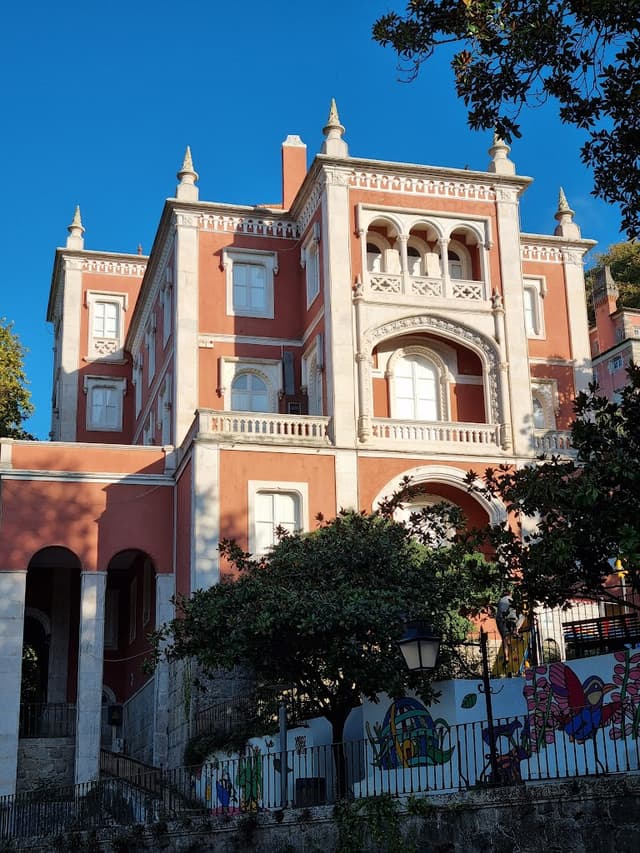
Palácio Valenças
@pedralexpereira
Once upon a time, in a village called Sintra, a rich merchant from Lisbon, António Ferreira dos Anjos, decided somewhere in the second half of the 19th century to build a palace that would come to mark the wonderful scenery of Sintra. Giuseppe Cinatti was the famous Italian architect chosen to build the palace where, until 1850, a slaughterhouse operated in the same location.
The palace was then built, surrounded by a majestic park, with fantastic paradisiacal gardens dotted with leisure corners, works of art, lakes, waterfalls and often ruined buildings that completed an environment conducive to nostalgic and evocative sensations of the important and ancient culture. European.
António Anjos, left the palace to his daughter D. Guilhermina Rosa Matos Anjos, who inherited it in the 19th century. The name of the palace and garden became known as Palácio Valenças because Luís Leite Pereira Jardim, 1st Count of Valenças, was Guilhermina's husband, and also, because the future heir, would be their son, Ricardo Anjos Jardim, 2nd Count of Valenças. Thus making the palace known by that name.

Details
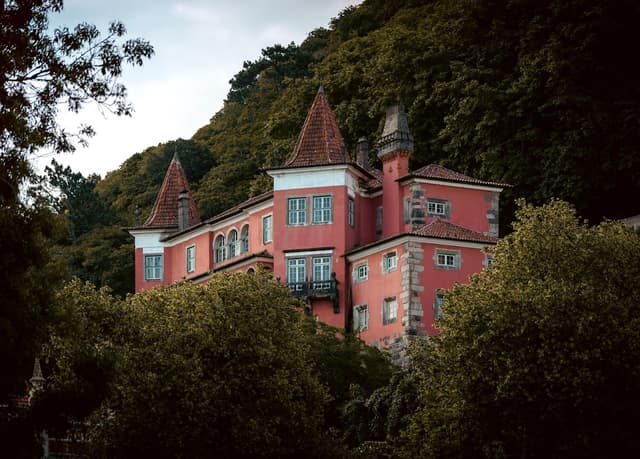
Casa Dos Penedos
@pedralexpereira
The Town of Sintra is made up of a significant group of buildings that span the most distinct historical periods. From the Muslim period to contemporary times, there are many architectural structures that we can find there. A place of choice for many of the most important and wealthy families in the country, Sintra has here and there fairytale palaces, the result of the dreams and budget of its owners and the work of notable architects such as Raul Lino.
Casa dos Penedos is one of these cases. The wealthy family of Carvalho Machado Ribeiro Ferreira, who had a considerable fortune due to investments in the financial sector, had their permanent residence in Lisbon, located on the privileged Avenida Fontes Pereira de Melo and built between 1902 and 1906 (which was demolished to give place in a building). For their summer residence, to be built in Sintra in 1922, they invited one of the best Portuguese architects – Raúl Lino, whom they had already used for their houses in Lisbon and Cascais. Located on the slope facing north of the Sintra mountain range, the house has a privileged view of the Sintra National Palace, the town itself and an open view of the Saloia area that plunges into the immensity of the Atlantic Sea.

Details
Fonte da Sabuga
@pedralexpereira
The current fountain was built in the 18th century, but the waters of Sabuga have been drunk and talked about since at least the 18th century. XII, at which time Crusader Osberno said that the coughing was calming down. In the century. In the 18th century, the fountain was redone twice, once due to the damage caused by the 1755 earthquake. It has spiers alternating with baroque pediments, with, in the center, the municipality's coat of arms surrounded by a thin border. Until 2005, the 3 walls of the fountain were covered with tile panels from the 17th century. XX, removed in the recent reform that proposed a more romantic vision of the fountain. Today, it is impossible not to notice the contrast of its colors - blue and yellow.

Details
House of Hans Christian Andersen (Casa do Adro)
@pedralexpereira
In 1866, the illustrious Danish writer Hans Christian Andersen lived in this house for some time. He came at the invitation of Jorge O’Neill, who met him in Copenhagen, between 1828 and 1832. We remember some of his words about the gesture of traveling: Oh! Travel! Travel! – It is, in fact, the happiest destiny! And that's why we travel, all of us, everything travels throughout the Universe! Even the poorest being has the winged horse of thought and when he becomes weak and old, then death takes it with him on a journey, we all travel!

Details
Palácio Duque de Saldanha
@pedralexpereira
The Quinta do Saldanha is a small L-shaped neo-gothic palace upon which construction works were carried out between 1860 and 1870. In front of its main elevation stands a medieval style portico, surmounted by a balcony and matching parapet. The chapel, whose only item of note is its magnificent, original Manueline portico, taken from the defunct Penha Longa convent is part of the building’s eastern wing.
On the land in front of this small palace stands a monument dedicated to Faith, commissioned by the Marshal-Duke in 1870, to the design of Possidónio da Silva and executed by master mason Filipe. Its pedestal bears the following epigraph: Only the Love of God which gives birth to the Love of Family, from which derives the Love of the Homeland can assure us of Happiness on Earth: in Heaven, Beatitude. Marshal-Duke of Saldanha, 1870.

Details
Largo Rainha Dona Amélia
@pedralexpereira
The square is named after Queen Amélia of Portugal, who was the wife of King Carlos I of Portugal. The square was built in the 19th century and is a fine example of neoclassical architecture.

Details
Fonte dos Pisões
@pedralexpereira
The current Fonte dos Pisões was built by the Tourism Initiative Commission in 1931, to replace another tank that had once existed there. Designed by José da Fonseca, it has a semicircular stepped predella flanked by two large vases. Its centre displays a large exuberant polychrome circle containing a low relief tile panel manufactured by the Fábrica Cerâmica Constância − Lisboa, depicting a scene in which putti drink water and carry pitchers among the foliage. Reference should be made to the inscription Salve from which a ribbed cup emerges.

Details

Largo da Quinta do Relógio
@pedralexpereira
The estate, or quinta in Portuguese, was acquired by José de Sousa Coutinho, 15th Count of Redondo during the second half of the 18th century. During the reign of Dom Pedro V of Portugal, the architect António Manuel da Fonseca Jr. was commissioned to design and construct the palace. His design was influenced by Romanticism and Mudéjar Moorish Revival architecture with Neo-Manueline elements. The style is similar to nearby Monserrate Palace and elements of Pena Palace. The Islamic architectural influence is in reference to when the region was a part of the wider Muslim Gharb Al-Andalus until the 13th century.
Later, the estate was acquired by a millionaire who ordered the construction of a clock tower (in Portuguese: Relógio) that would give the estate its name. The clock tower was later demolished and it is unclear where exactly its location was.
The palace is considered one of the most important monuments of the Portuguese Moorish Revival style. It is on the perimeter of the Natural Park of Sintra-Cascais.
Above the main entrance there is an Arabic inscription which reads: "Wa lā ghāliba illā-llāh (There is no victor but God)" which was the motto of the Emir of Granada.
The house has four floors with about 1500m2 of floor area. The estate has an area of 22.144m2.[7] Next to the actual palace is also the house of servants, which has been refurbished.

Details
Museums and cultural venues
MU.SA - Museu das Artes de Sintra
@pedralexpereira
The museum is housed in a former casino, which was built in the early 20th century. The museum was opened in 2013 and is dedicated to the contemporary art of Portugal.
The museum's collection includes works by a number of Portuguese artists, including Paula Rego, Júlio Pomar, and Vieira Lusitano. The museum also hosts a number of temporary exhibitions throughout the year.

Details
Olga Cadaval Cultural Center
@pedralexpereira
The Centro Cultural Olga Cadaval was inaugurated in 2001 and is named after Olga Cadaval, a Portuguese philanthropist. The center is housed in a renovated historic cinema, the Cine-Teatro Carlos Manuel.
The Centro Cultural Olga Cadaval has two performance halls:
The Sala de Teatro, or the Theater Hall, is the larger of the two halls, with a capacity of 1005 seats. It is named after Jorge Sampaio, a former president of Portugal.
The Sala de Cinema, or the Cinema Hall, is a smaller hall with a capacity of 276 seats.

Details
Museu Anjos Teixeira
@pedralexpereira
The museum is housed in a former mill, which was built in the 18th century. The museum was opened in 1976 and is owned by the Municipality of Sintra.
The museum's collection includes over 200 sculptures by Artur Gaspar dos Anjos Teixeira and Pedro Anjos Teixeira. The sculptures are made of a variety of materials, including marble, bronze, and wood.
The museum also has a collection of drawings, paintings, and other works of art by the two sculptors.

Details
Sintra National Palace
@pedralexpereira
The National Palace of Sintra, also known as Palácio da Vila, was one of the palaces used by the Portuguese Royal Family practically until the end of the Monarchy, in 1910.
Urban implantation, its construction began in the 15th century, with traces of an unknown author.
It presents features of medieval, Gothic, Manueline, Renaissance and Romantic architecture. It is considered an example of organic architecture, a set of apparently separate bodies, but which are part of a whole linked to each other, through courtyards, stairs, corridors and galleries. It has the largest set of Mudéjar tiles in the country.
It is dominated by two large twin chimneys that crown the kitchen and constitute the "ex-libris" of Sintra.

Details
Museu de História Natural de Sintra
@pedralexpereira
The Sintra Natural History Museum is located in the heart of the Historic Center of Vila Velha de Sintra, on Rua do Paço, in a 19th century building, more specifically from 1893. There, a long-term exhibition is open to the public, the genesis of which It came into the hands of collector Miguel Barbosa and his wife, Fernanda Barbosa, who, for around 50 years, gathered a unique collection made up of thousands of fossils of incalculable cultural and scientific value.

Details

Museu Ferreira de Castro
@pedralexpereira
The Ferreira de Castro Museum is located in the heart of Vila Velha de Sintra, in Casal de Santo António. It contains the private, literary and artistic estate of the great Portuguese novelist Ferreira de Castro (1898-1974), donated by him to the people of Sintra, a year before he passed away.
The writer's office was reconstituted according to what existed in his house in Lisbon. In addition to personal objects and writings, the portraits by Eduardo Malta, Roberto Nobre and Stuart Carvalhais stand out. The Museum also displays paintings and drawings by Bernardo Marques, Cândido Portinari, Elena Muriel, Jorge Barradas and Júlio Pomar, among others, and sculptures by António Duarte, Anjos Teixeira and Júlio de Sousa.
Ferreira de Castro's documentary collection consists of more than 20 thousand epistolary documents, periodicals, manuscripts, photographs, and is accessible to researchers.
His work was awarded several prizes (Ricardo Malheiros, Paris Academy of Fine Arts, Golden Eagle at the Nice Book Festival, Latin Union), being nominated twice for the Nobel Prize for Literature.

Details
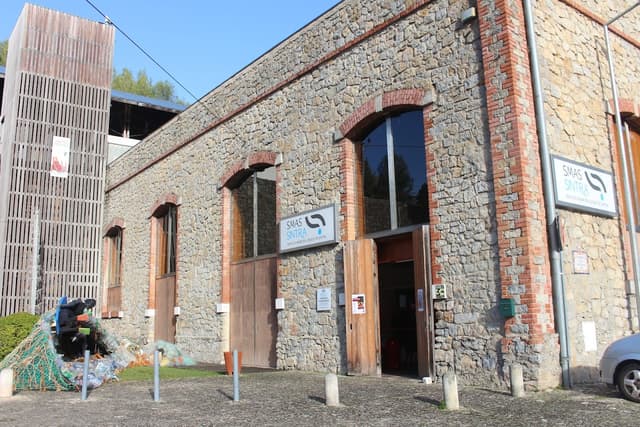
Sintra Science Workshop
@pedralexpereira
Sintra opened the doors to the Water and Waste Museum (MAR), located on the premises of the former Science Workshop, in Ribeira de Sintra. This new museum space is a reference hub in the areas of environmental education and awareness, as well as scientific and technological dissemination in the context of the urban water and waste cycle.
The management of this space is the responsibility of SMAS, given its public service mission in the environmental area, in the areas of water supply, drainage and wastewater treatment and collection and transport of urban waste, without neglecting education and awareness of preservation of the environment.
MAR will have a diverse program, with the aim of attracting new audiences, but focused on the educational community, through education and community awareness-raising actions for the adoption of values and habits related to the preservation of environmental heritage, especially with regard to to the water cycle, promoting and organizing courses, internships, seminars, meetings, exhibitions and training.

Details
NewsMuseum
@pedralexpereira
The museum occupies the former premises of the Toy Museum, in the historic center of Sintra, and invokes and explains the media coverage of episodes from recent history, allowing visitors to interact with Radio and TV.
It pays homage to the journalists immortalized by their work, presents the main protagonists of the industry, projects the evolution of war reporting, contextualizes the media battles that marked us, recalls the "bad news" of our time.
The equipment is very modern and participatory, including a small auditorium prepared for educational visits. The experience, available in Portuguese and English, is personalized in a total of 16 hours of video and other formats.

Details
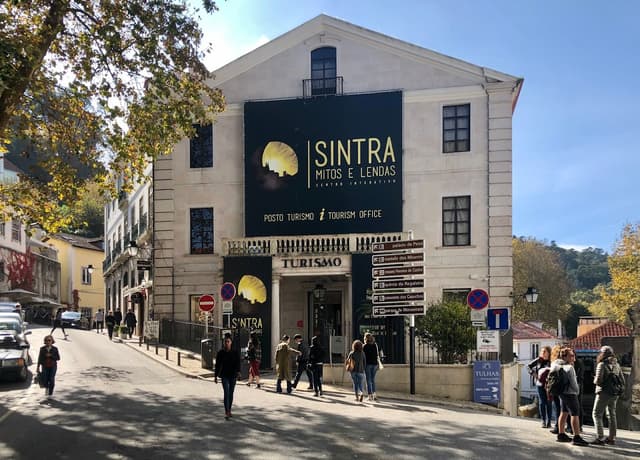
Sintra Mitos & Lendas
@pedralexpereira
The Sintra Myths and Legends interactive center invites you to take a journey through the mysticism, secrets and romanticism of the village, through history, music and literature.
Using scenography, multimedia techniques and sensory experiences, the route of 17 spaces crosses reality and fiction in various dimensions, with the participation of a team of architects, set designers, scriptwriters, historians and experts in audiovisuals, holograms, sensory effects, augmented reality and 3D films.
The expedition through the myths and legends of Sintra begins in an elevator covered with images of the town, to the sound of the forest and with dimmed lights, but it is on Floor 3 that the starting point of the visit is found, with the feeling of having arrived at the top of the Sintra mountain range.
Here, a narrator introduces the concept of legends and talks about the moment of the Creation of Penhas – Legend of the Five Heights of Same Names and Different Surnames of Sintra so that, on the 2nd Floor, visitors begin to come into contact with historical events and other legends, through touchscreen screens and an animated film on screens, using video mapping, supported by audio guide narrations.
On the 1st floor you can learn about the legends of the Tomb of the Two Brothers and the Seven Woes. To tell them, holograms of real dimensions are recreated that give spectacularity to the story, but also, kinetic experiences are created, in which visitors embody a character from a game, running through the woods, avoiding obstacles and collecting some of the elements associated with the legend. At the seventh “Ai” the player loses.
In a space dedicated to writers who were seduced by the magical town of Sintra, animated images of them are displayed, with narration of their experiences told in the first person. Here, in a 4D space, through a multisensory experience complemented by smell and wind mechanisms, the legend of the appearance of Our Lady to the mute girl who was herding a flock of sheep in the mountains is explained.
On Floor -1, new adventures await visitors, such as entering a tunnel that simulates the Initiatory Well; the immersive experience of being on board a boat, watching the Adamastor, while being enveloped by the sea waves; or even the scenography and holograms that recreate the pagan universe omnipresent in legends and myths, through nature, animals and fairies. The visit ends surrounded by the magic of green, to the sound of the forest.

Details
Parks and gardens
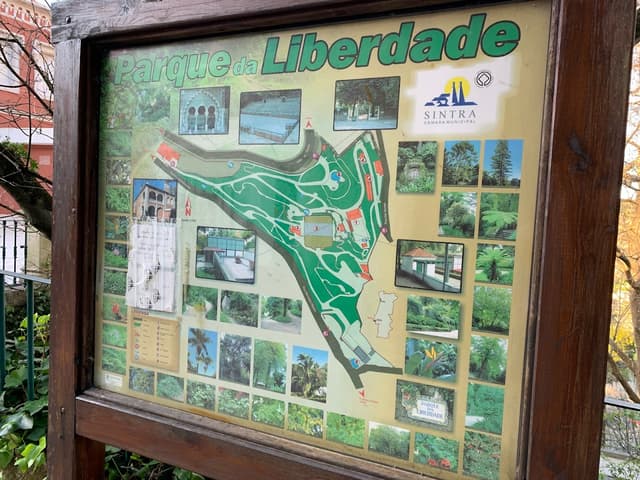
Park Liberdade
@pedralexpereira
The announcement of the acquisition of Valenças Park by the Sintra Tourism Commission dates back to 1936, with the purpose of providing Sintra with a Public Park. Classified as a major improvement, it would fill what was considered a gap, because: (...) it was not right that, as this town was known for its land of gardens and flowers, its inhabitants and tourists did not have a Public Park, where they could take a walk or rest from their fatigue (...).
Parque da Liberdade was inaugurated in July 1937, in the presence of the President of the Republic. In August 1939 it would be in the news again, to welcome the improvements introduced in the meantime, with a special emphasis on the tennis court and the then inaugurated skating court.
Since then, this park has functioned as a main visiting point in Sintra, successively undergoing improvements and maintenance. The vegetation cover of Parque da Liberdade is characterized by an essentially natural development, with an aesthetic, a landscape and a set of interactions that allow a varied number of ecological niches, increasing biodiversity.

Details
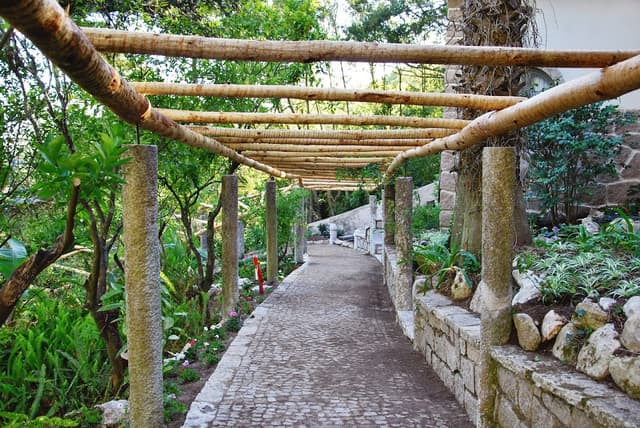
Villa Sassetti
@pedralexpereira
The history of this place began in 1885 with the acquisition of the land by Victor Carlos Sassetti (1851-1915), a native of Sintra and an eternal lover of the mountains. In this place, he would build his summer house, inspired by the castles of Lombardy, and the garden that surrounds it.
Work on this revivalist project began in 1890, developed with the help of friend Luigi Manini, architect and scenographer who designed, among others, the Quinta da Regaleira building.
The 1.2 hectares that make up this corner were imagined by these two friends, inspired by the Lombard castles, in northern Italy, the region where the architect (Crema) and the Sasseti family were originally from, and with the aim of creating the perfect symbiosis between natural space and built space.
The garden seeks to comply with a scenographic aesthetic, along a winding path, crossed by an artificial water line, expressing a profound relationship of harmony between architecture and landscape.
After the death of Victor Sassetti, the place was leased to the Armenian millionaire Calouste Gulbenkian, between 1920 and 1955, and later, to Isabel Armanda Luísa Real. The new owner ordered the construction of the Casa do Caseiro and expanded the main building, adding the current east section and sanitary facilities. It was around this time that the village changed its name, becoming Quinta da Amizade

Details
Parque das Merendas
@pedralexpereira
In this park you can enjoy a pleasant environment, with an extraordinary landscape and "views as far as the eye can see".
With more than half a thousand large and medium-sized trees, you can take advantage of the shade and stone tables and benches to have a snack, read or rest.

Details
Quinta da Regaleira
Sintra was, in the 19th century, one of the first cradles of romantic architecture in Europe. Its unique climate and consequent nature attracted the eyes of those who, touched by the landscape, dared to retouch it with stunning architecture in Edenic harmony conducive to the contemplation of the Beautiful and the Sublime.
It is in this painterly setting that we find, just outside the historic center of Sintra, Quinta da Regaleira. Designed and built during the late 1800s, it reflects the sensitivity and cultural, philosophical and scientific interests of the principal owner, António Augusto de Carvalho Monteiro (1848-1920), combined with the virtuosity of the Italian architect-scenographer Luigi Manini (1848-1936 ). The culture and creativity of these two personalities resulted in an eclectic-revivalist architectural ensemble, with a particular focus on the Manueline and Renaissance styles. Medieval and Classical.
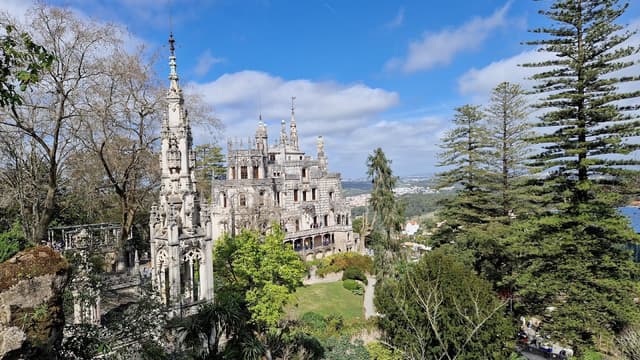
Quinta da Regaleira Palace
@pedralexpereira
Acquired by Baroness da Regaleira, daughter of Alfredo Allen, a wealthy Porto merchant in 1840, the property became a gallant summer retreat, with a mansion, chapel and garden and became known as Quinta da Torre da Regaleira.
In 1893 it was sold at public auction by António Augusto Carvalho Monteiro (1848-1920), a man of vast culture, whose fortune had been accumulated in Brazil, who added other parcels of land to it, taking its current form. Carvalho Monteiro, a deep lover of the glorious national epic, translated at the time by the 'revivalist' taste of neo-Manueline architecture, was inspired for the construction of his mansion and respective chapel, both by the structural and decorative eclecticism of Pena, and by the assumed neo-Manueline style of Buçaco Palace, the latter designed by Luigi Manini (1848-1936).
Some of the spaced interiors that stand out are:
- Hunting Room: The dining room is dominated by the monumental fireplace topped by the sculpture of Monteiro. In this fireplace, the theme of hunting stands out with exceptional execution in stonework. From the polychromy of the Venetian mosaic to the corbels of the vault, the theme of the cycle of life shines through.
- Octagonal Room: Suggests the Charola of the Convent of Christ in Tomar
- Sala dos Reis: Former billiards room, 20 kings and 4 queens of the Portuguese monarchy and the shields of the cities of Braga, Porto, Lisbon and Coimbra are represented there

Details
Capela da Quinta da Regaleira
@pedralexpereira
The Neo-Manueline Chapel highlights a rich iconological program with, as its central theme, the Marian and Christ cycle, with emphasis on the scenes of the Annunciation and Coronation of Mary.
Its symbolism also alludes to the Order of Christ, heir to the Order of the Templars.
The crypt has an underground access connecting to the Palace.

Details
Torre da Regaleira
@pedralexpereira
It was built to give those who climb it the illusion of finding themselves on the axis of the world.

Details
Gruta do Labirinto
@pedralexpereira
One of the great features of Quinta da Regaleira is the immensity of symbolism spread throughout.
The Labyrinth Cave, together with the lake, leads us to believe that there are several underground paths underneath, which can lead to different directions, which in themselves only deepen the mystery that exists in this incredible place.

Details
Pisoes Waterfall
@pedralexpereira
This small waterfall is very close to Quinta da Regaleira, and interrupts a line of high walls that flank the road. The green setting and the sound of running water make that place unique. Another of the natural beauties that Sintra offers to those who visit it.

Details
Poço Imperfeito
@pedralexpereira
Imperfect Well. A charm measuring around 15 meters high, with 55 steps divided into 5 levels of 11 steps each and which, despite its rough and unfinished appearance, is one of the favorite places for visitors.

Details
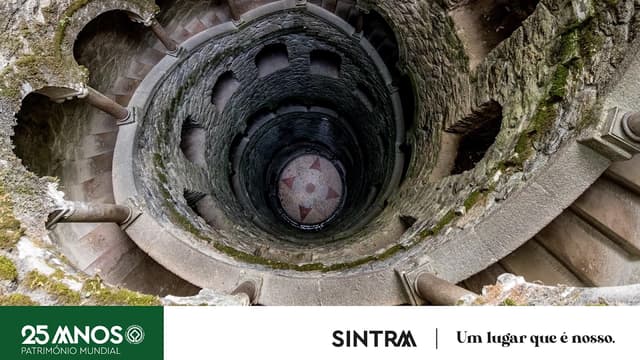
Initiation Well
@pedralexpereira
It is an underground gallery with a spiral staircase, supported by carved columns, through which you descend to the bottom of the well. The staircase consists of nine levels separated by flights of 15 steps each, invoking references to Dante's Divine Comedy and which may represent the 9 circles of Hell, Paradise, or Purgatory. According to the renowned occultists Albert Pike, René Guénon and Manly Palmer Hall, it is in the work The Divine Comedy that the Rosicrucian Order is first exposed. At the bottom of the well is embedded, in marble, a wind rose (eight-pointed star: 4 major or cardinal, 4 minor or collateral) on a templar cross, which is Carvalho Monteiro's heraldic emblem and, at the same time, indicative of the Rosicrucian Order.
The well is called initiatory because it is believed that it was used in initiation rituals into Freemasonry and the explanation of the symbolism of the same nine levels is said to be found in the work Rosicrucian Concept of the Cosmos.
The symbolism of the place is related to the belief that the earth is the mother's womb from which life comes, but also the grave to which it will return. Many initiation rites allude to earth-bound aspects of birth and death, or rebirth. The existence of 23 niches located beneath the steps of the initiation well represented one of the many mysteries of that construction. On December 29, 2010, professor Gabriel Fernández Calvo from the Higher Technical School of Paths, Canals and Ports Engineers at the University of Castilla-La Mancha in Ciudad Real, when visiting the well accompanied by other professors from UCLM, observed that the 23 niches are not placed by chance, as they are grouped into three sets of 17, 1 and 5 niches separated from each other as you descend to the bottom of the well. This organization is not random and probably refers to the year 1715 in which Francisco Albertino Guimarães de Castro purchased the property (known as Quinta da Torre or do Castro) at public auction.
The well is connected by several galleries or tunnels to other parts of the Quinta, the Gate of the Guardiães, the Lago da Cascata and the Poço Imperfeito. These tunnels, once inhabited by bats driven away by the many tourists who visit the site, are covered with stone imported from the seafront in the Peniche region, a stone that gives the suggestion of a submerged world.

Details
Parque Biester
Watched for a long time by those who pass through these parts, by those who explore everything there is to visit around the most romantic village in Portugal, the Biester Palace is the new 19th century treasure to discover in Sintra, having been opened to the public in 2022.
This is one of those spaces in the town that has most intrigued those passing by on their way, for example, to Quinta da Regaleira, which is right next door, or to Palácio da Pena or Castelo dos Mouros, which can also be seen from of this “new” attraction in Sintra.
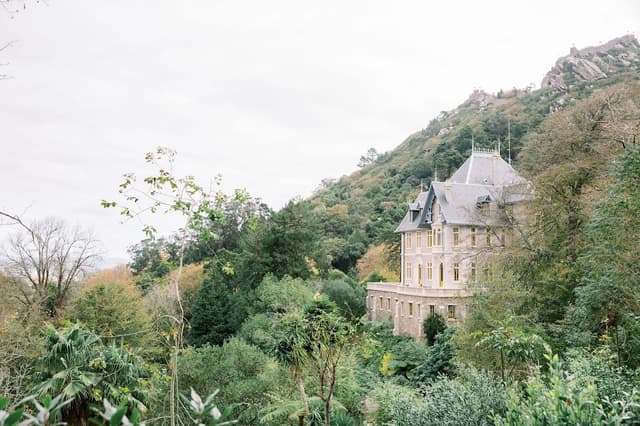
Palácio e Parque Biester
@pedralexpereira
The Biester Palace is a unique example of romantic architecture, having been the residence of the Biester family, who commissioned it from José Luiz Monteiro, a renowned architect of national architecture, who gave it a unique decoration and several artistic details, which were carried out by the master. carver Leandro Braga and artists Luigi Manini and Paul Baudry.
The Botanical Park
The paths are very well marked and the places of greatest interest, which deserve a longer visit, are duly documented using small black signs (with descriptions in Portuguese and English).
Pena Cave
This space stands out as one of the refuge points in the Biester Palace Botanical Park. The formation is natural and offers a rocky recess where large rounded rocks seem to be suspended to provide a very pleasant interior space.
Viewpoints: the Castle and the Discoveries
From the Biester Palace Botanical Park you can find two fantastic viewpoints, one of them with an incredible panoramic view over the entire park.
The first viewpoint is called Miradouro do Castelo, it is located next to the picnic park and has one of the most privileged views of the town of Sintra, directly towards the Castelo dos Mouros.
The Discoveries Viewpoint is the more incredible of the two! It's in one of the park's deserted areas, but the trip there is more than justified... and mandatory!

Details
Castelo dos Mouros
With a privileged view over the Atlantic Coast, the floodplains and the Serra de Sintra, the ancient Moorish Castle, of Muslim foundation, occupied a fundamental strategic position in the defense of the local territory and maritime access to the city of Lisbon.
The artefacts found there indicate that, between the walls and around them, a village lived there, in a space now called the Islamic Quarter.
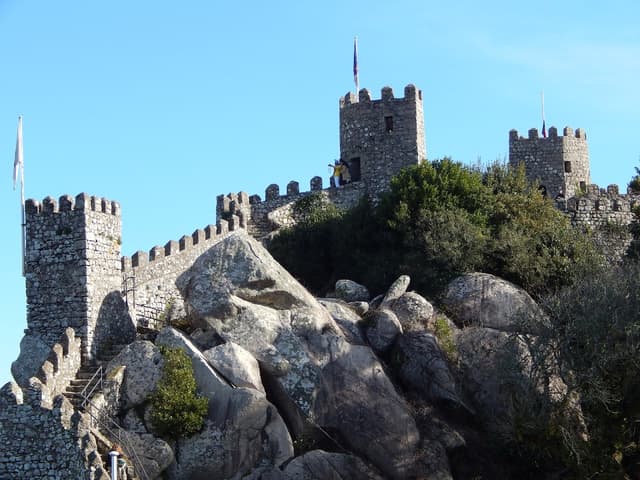
Castelo dos Mouros
@pedralexpereira
The Moors lived there until 1147, when Sintra was handed over to D. Afonso Henriques, the first king of Portugal, following the conquest of the cities of Lisbon and Santarém. Strategically and in order to defend the territory, the management of the town of Sintra and its surrounding area was donated to Gualdim Pais, master of the Order of the Temple, receiving a charter in 1154.
With the settlement of Christian populations in the Castle of the Moors, the Islamic Quarter began to disappear and gave way to a medieval town, whose occupation lasted until the 15th century, when it was progressively abandoned once the conflicts between Moors and Christians, the populations no longer needed to take shelter near the fortification. The Church of São Pedro de Canaferrim was part of this medieval village, built between the two belts of walls.
In the 19th century, in accordance with the romantic spirit of the time, D. Fernando II carried out restoration work on the castle, reviving the medieval imagery that surrounds the place. These works damaged part of the Christian necropolis of the Church and, for this reason, a tomb was ordered to be built to bury the bones found. As it is not known whether these were Christian or Muslim human remains, it reads: “What man has gathered together, only God can separate”.

Details
Pena National Park
The history of this magical place begins in the 12th century, when there was a chapel dedicated to Our Lady of Pena there. In this same location, D. Manuel I ordered the construction of a monastery, the Royal Monastery of Nossa Senhora da Pena, later handed over to the Order of Saint Jerome.
The earthquake that hit Lisbon in 1755 left the monastery practically in ruins. Even though it was dilapidated, the Monastery maintained its activity, but, after almost a hundred years, in 1834 when the religious orders in Portugal became extinct, it was left abandoned. Parque da Pena still has corners that refer to this era, such as the Monk's Cave, a place where monks practiced seclusion.

National Palace of Pena
@pedralexpereira
The fantastic Pena Palace is one of the greatest examples of romantic revivalism of the 19th century. XIX in Portugal.
Located on Monte da Pena, the Palace was built on the site of an old convent of friars of the Order of Saint Jerome. It was the fruit of the imagination of D. Fernando de Saxe Coburgo-Gotha, who married Queen D. Maria II in 1836. In love with Sintra, he decided to acquire the convent and the surrounding land to build the royal family's summer palace.
The king consort adopted Portuguese architectural and decorative forms for the palace, in the revivalist style (neo-Gothic, neo-Manueline, neo-Islamic, neo-Renaissance) and in the surrounding area he decided to create a magnificent English-style park, with the most varied tree species exotic.
Inside, still decorated to the taste of the kings who lived there, the chapel stands out, where you can see a magnificent alabaster marble altarpiece attributed to Nicolau Chanterenne (one of the architects of the Jerónimos Monastery, in Lisbon). Also worth mentioning are the trompe l’oeil murals and tile coverings.

Details
Temple of Columns
@pedralexpereira
The Temple of the Columns, with its yellow dome supported by twelve columns, stands out among the treetops. This neoclassical building with a circular plan was built on the site where there was an old votive chapel to Saint Anthony, also with a circular plan, which had succumbed to the 1755 earthquake.

Details
The Warrior Statue
@pedralexpereira
From the vicinity of the Temple of Columns you can see the statue of the Warrior, designed by the sculptor Ernesto Rusconi, dating from 1848, and which stands like a sentry over the domains of Pena. It will be a possible representation of D. Fernando II as the eternal guardian of his work, since on the shield it is possible to see a caravel with its sails retracted, alluding to the successful arrival of this German prince who made Portugal his homeland.

Details
Cruz Alta
@pedralexpereira
It is the highest point in the Serra de Sintra, at 528 meters above sea level, from where it is possible to see the most beautiful views over Lisbon and Cascais, to the south, the Atlantic Ocean, to the west, and the Saloia region, to the north.
In this place, by order of D. João III, a cross was placed (ca. 1522) which was later destroyed by a storm. To replace the original cross, D. Fernando II had a new cross installed in the same location, which was, in turn, destroyed by lightning in 1997.
In 2008, a new replica of the cross was built in a single block of limestone. This new cross, 3.5 meters high, 1.5 meters wide and weighing approximately 1,700 kilos, imitates intertwined trunks and is hollowed out in several points, which made the execution of the replica and its transport to the particularly difficult locations.

Details
Abegoaria e Quinta da Pena
@pedralexpereira
Located in the western part of Parque da Pena, it was created in 1843 following the concept of Ferme Ornée (Ornamental Farm), in which the productive and scenic functions provided pleasant “country walks” in the romantic setting of the Pena arboretum.
The central and dominant point of Quinta da Pena is the Abegoaria, a building that had functions to support agricultural activities, with stables and a warehouse for animal feed and farming instruments.
This complex also includes greenhouses, a set of buildings designed to produce plant species to be planted in the Park. Greenhouses have been, over time, the basis of the Parque da Pena arboretum and a fundamental element for the maintenance of the park and its botanical collection.

Details
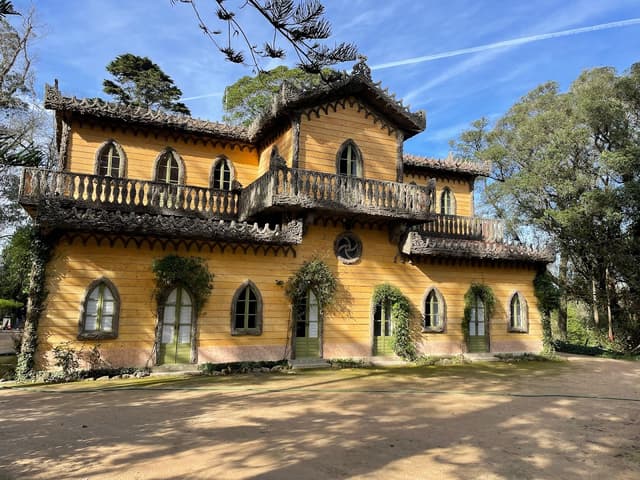
Chalet of the Countess of Edla
@pedralexpereira
Sintra Chalet Parks and Gardens of Countess Dedla
Elise Hensler was born in Switzerland in 1836 and lived for many years in Boston, in the United States of America. She was a woman with great culture and a deep passion for the world of arts and letters, who became an opera singer. After studying in Paris and acting in Milan, Elise visited the Portuguese stages, passing through the Teatro Nacional de São João, in Porto and, later, at the Teatro Nacional de São Carlos, in Lisbon. It was on this last stage that King D. Fernando II met her and fell in love with her.
In 1869, with D. Luís I already on the throne, D. Fernando II and Elise married, united by their love of art and culture. The marriage took place after D. Fernando asked his cousin, Duke Ernest II of Saxe-Coburg and Gotha, for a title for his future wife: Countess d’Edla. Opinions about the wedding, both among the nobility and the press, were quite divided, and it was never really accepted by the public.
The couple used Sintra, more specifically the Pena Park and Palace, owned by D. Fernando II, as their refuge. Both passionate about botany, they intensified planting in the park, including species from various parts of the world in this romantic garden.
In one of the corners of the park, the couple began construction of a chalet that the countess herself designed and designed. Both the chalet and the garden around it are extremely romantic and private. Strategically located to the west of the Pena Palace, the building is inspired by alpine chalets, a style that was very popular in Europe at the time. The chalet has a scenographic setting, which reflects the couple's artistic facets. With a singular taste, its facade and interiors are unparalleled. Outside, the garden surrounding the chalet offers an exotic landscape featuring Feteira da Condessa, Jardim da Joina, Caramanchão and the labyrinth of Pedras do Chalet.
Upon the death of D. Fernando, in 1885, the king left all his assets, including the Castelo dos Mouros and the Palácio da Pena, to the Countess d’ Edla in his will. After a legal process – which aimed to pass this heritage to the Portuguese Crown –, Elise ended up selling the Pena Park and Palace and the Castelo dos Mouros to the State, remaining with usufruct of the chalet and its garden until 1904.
In 1999, the Chalet da Condessa d'Edla was consumed by a fire, having reopened to the public in 2011, after four years of restoration work in which Parques de Sintra carried out the reconstruction of this building of great cultural and historical value. and artistic. The project was distinguished in 2013 with the European Union Prize for Cultural Heritage – Europa Nostra, in the Conservation category.

Details
Monserrate
A retreat for writers, Monserrate attracted numerous foreign travelers, especially English ones, who extolled its beauty in travel reports and engravings. When Francis Cook, a wealthy 19th-century English industrialist and major art collector, visited the site, he was fascinated. From this passion was born a masterpiece of Romanticism: the Park and Palace of Monserrate.
Francis Cook materialized his dream, transforming Monserrate into what we know today, with its lush gardens – which dazzle the visitor with exotic species from the four corners of the world – and a palace that is a true ode to romantic architecture and refined taste. by Francis Cook and the genius of architect James Knowles Jr., who combined several influences there.
However, the history of this enchanting place has been marked by many vicissitudes. Behind its majestic, profusely crafted walls, Monserrate hides very different pasts, which have always enhanced its natural beauty.

Park and Palace of Monserrate
@pedralexpereira
The history of Monserrate begins in 1540, when Friar Gaspar Preto ordered the construction of a hermitage dedicated to Our Lady of Monserrate, after a trip through the Iberian Peninsula, in which he marveled at the hermitage of Montserrat in Catalonia, near Barcelona. The property then belonged to the Hospital de Todos os Santos in Lisbon, of which Frei Gaspar Preto was rector and remained that way, as a place of worship and production of agricultural products intended for the Hospital's consumption.
In the 17th century, the Mello e Castro family took possession of Quinta de Monserrate and, in 1718, D. Caetano de Mello e Castro, Commander of Christ and Viceroy of India, acquired the farm. However, a few years later, in 1755, the Lisbon earthquake devastated the place, leaving a large trail of destruction. Even in poor condition, in 1789 the site was leased to Gerard de Visme, an English merchant who had a neo-Gothic style castle built there, but who lived there for a few years.
In 1794, the English writer William Beckford became the new tenant of Monserrate. After that, restoration work is carried out on the building and the immense gardens that surround it. The place was abandoned again in 1799, when the writer left the property. The lease contract only ended eight years later.
Even in a state of decline, the place attracts numerous foreign travelers, especially English ones. It is visited by Lord Byron, an illustrious poet with an unshakable link to the Romantic movement, who expressed his love for Monserrate in the poem "Childe Harold's Pilgrimage".
It was then in 1863, after so many owners, stories, restorations and abandonments, that Francis Cook, an English merchant and art collector, became the owner of Quinta de Monserrate and the 1st Viscount of Monserrate. There he ordered the construction of a palace that combines Gothic, Indian influences and Moorish suggestions. The exotic and vegetal motifs of the interior decoration extend harmoniously to the exterior, which has also been redesigned and transformed into one of the most beautiful Portuguese botanical gardens.
Constituting one of the most notable landscape creations of Romanticism in Portugal, the Monserrate Park received species from all over the world, which were organized by geographical areas, reflecting the diverse origins of the plants and composing scenes along paths, among ruins, corners , lakes and waterfalls. It is thus, mainly thanks to the intervention of the landscaper William Stockdale, the botanist William Neville and the master gardener James Burt but, above all, to the romantic spirit of Francis Cook, that we can today find in Monserrate Park contrasting scenes that, throughout winding paths and in coexistence with spontaneous species of the region, such as the arboreal strawberry trees, the now very rare hollies and the imposing cork oaks, ancient tree ferns and araucaria, agaves and palm trees appear that recreate a scene from Mexico, camellias, azaleas, rhododendrons and bamboos, reminiscent of a Japanese garden.

Details
Ruínas da Capela de Monserrate
@pedralexpereira
False ruin by Francis Cook created from the chapel built by Gerard de Visme to replace the old chapel of Our Lady of Monserrate.
Swallowed by vegetation, the ruin is now inseparable from the Australian Rubber Tree. The Chapel's niche contained one of three Etruscan sarcophagi that served as garden ornaments.

Details
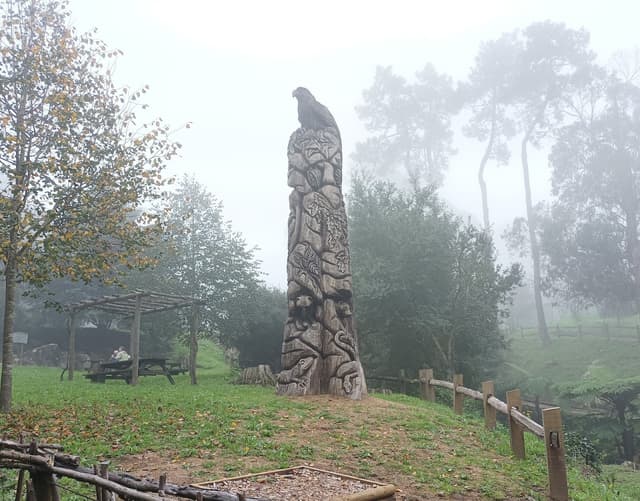
Quintinha de Monserrate
@pedralexpereira
With an area of around two hectares, native trees and a water line, Quintinha de Monserrate recreates a small agricultural farm, with areas dedicated to different types of crops and animals, as well as a renewable energy system that makes it completely autonomous. from an energy point of view. It was, at one time, a small rural farm that served the Park and Palace of Monserrate, the property to which it is adjacent.
The caretaker's old 19th-century house provides suitable spaces for educational activities, such as a work room with a stove and a kitchen with a bread oven that allows the atmosphere of traditional cuisine to be reproduced in workshops in which the farm's products are used.
Plantations include areas of orchards, vegetables, wild and berry plants, cereals and aromatic plants. In the surrounding area, there is a pen for horses, donkeys and sheep, a rabbit hutch and a shelter for poultry. The space also has a picnic area, an outdoor amphitheater and a barn.
The water line that runs through Quintinha is fed by the natural springs and water mines of Tapada de Monserrate, constituting a privileged habitat for amphibians and aquatic animals. On the other hand, it feeds a traditional levada irrigation system, which has a high pedagogical value as it allows for numerous thematic approaches.

Details
Santuário da Peninha
High up, at 488 meters above sea level, the Peninha Sanctuary enchants with its unshakable magic and mystique. Built out of popular devotion, the Chapel of Nossa Senhora da Penha (Peninha) arises following a supposed apparition of Our Lady to a poor shepherdess. This architectural complex also consists of the centuries-old hermitage of São Saturnino and an enigmatic romantic-revivalist palace built in 1918 by António Augusto Carvalho Monteiro (owner of Quinta da Regaleira).
A place of worship since ancient times and heir to a long magical-religious tradition, it is shrouded in legends that have passed down generations of pilgrims.
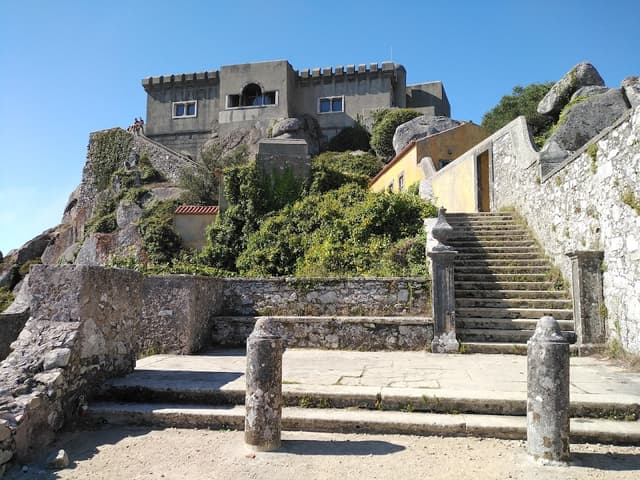
Sanctuary of Peninha
@pedralexpereira
Sintra Parks Santuario Da Peninha Image 02
It is impossible to dissociate the history of this Sanctuary from its legend. This tells us that, during the reign of D. João III, a mute and very poor shepherdess, born in Almoinhas Velhas, who had the habit of walking her sheep in the surrounding area, lost one of her sheep. In the distance, she saw a lady who was carrying the lost sheep with her. Being mute, the pastor thanked him as best she could. The lady asked her for some bread, but the shepherdess told her that she didn't have any, as she was very poor.
The lady then told her that when she got home she should call her mother and ask her for bread. The shepherdess, who knew she had no bread at home and was aware that, being mute, she could not call for her mother, explained to the lady that it was impossible to carry out such a task. After much insistence, the pastor agreed.
Upon arriving, she called for her mother and, miraculously, her voice was heard. She explained what had happened and together they went in search of bread around the house. In a chest, they found enough bread to feed the entire village and end the times of hunger.
As a thank you, the whole village went up to the mountain where the meeting with the lady had taken place and, in the exact place of the event, they saw the image of Our Lady. From that moment on, this became a place of sacred worship.
At the end of the 17th century, Frei Pedro da Conceição, with the support of alms from the faithful and King Pedro II, ordered the construction of a chapel dedicated to Our Lady of Peninha, as well as the pilgrims' houses that served as support for pilgrims.
However, this was not the first temple built on the site whose sacredness has been lost to time. Already in the 12th century there was a hermitage called São Saturnino, the work of Pêro Pais, ensign and standard bearer of the first king of Portugal, D. Afonso Henriques.

Details
Convento dos Capuchos
Located in the middle of the Serra de Sintra, the Convento dos Capuchos contrasts with the lavish and exuberant buildings that exist in Sintra. This Franciscan convent stands out for its simplicity, completely devoid of luxury and comfort.
Its small dimensions and notable poor construction are part of the mystique of this monument. Here, human construction merges with pre-existing natural elements, the surrounding vegetation and the enormous granite boulders, which constitute what was considered by the inhabitants of this convent house as a “divine construction”. The forest that surrounds the building was kept intact by the friars who lived there, and today is one of the most notable examples of Sintra's primitive forest.
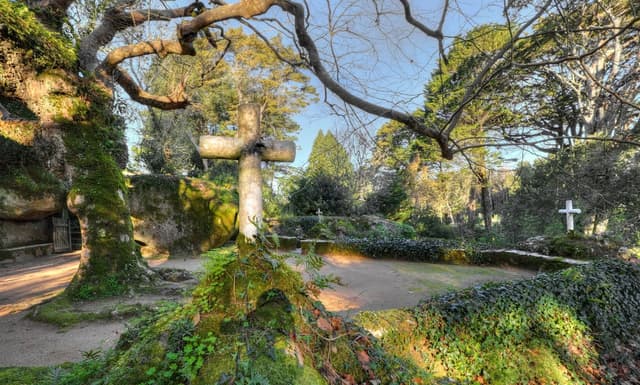
Capuchos Convent
@pedralexpereira
Also known as Convento da Cortiça, the construction of this conventual house was promoted, in 1560, by D. Álvaro de Castro, state advisor to King D. Sebastião, as a result of a vote he made to his father, D. João de Castro , who dreamed of building a stripped-down temple there, dedicated to the practices of contemplation and introspection. This convent, where cork was used extensively in coverings and decoration, was named Convento de Santa Cruz da Serra de Sintra. The construction embodies the philosophy and ideals of the Order of Saint Francis of Assisi: the search for spiritual improvement through isolation from the world and renunciation of the pleasures associated with earthly life.
Later, by order of Cardinal King D. Henrique, the convent received some improvements.
In 1581, after the Portuguese defeat in the battle of Alcácer-Quibir, Philip I of Portugal (II of Spain) visited the convent, making a statement that became famous: “Throughout my kingdom, I am very pleased with two things: Escorial, for being so rich, and the Convent of Santa Cruz, for being so poor.”
For around 250 years, the convent remained a place of worship and pilgrimage, inhabited by Franciscan friars who the local population considered “holy men”, who shared the philosophy expressed in that place. One of the notable friars in the history of this house was Friar Honório who, according to legend, spent the last decades of his life isolated, on bread and water, in a small cave in the convent's woods, after having given in to temptation. However, in 1834, after the extinction of the Religious Orders in Portugal, the convent was abandoned and was later purchased by the 2nd Count of Penamacor, who, in 1873, sold the property to the 1st Viscount of Monserrate, Francis Cook.

Details
Queluz
The National Palace of Queluz charms whether for its imposing nature or the sheer exuberance of its architectural details closely bound up with the lives of three generations of the Portuguese Royal Family and the scene of intense emotions. The Palace furthermore reflects the evolution in the tastes and styles over different period, moving from the Baroque to the Rococo and onto Neoclassicism.
Its surrounding scenic gardens invite you for a “stroll” through a period in which the court organised sumptuous parties and that hold the memories of trips by gondola along the canal, theatre, hunting, musical and literary performances, masked balls, games and open-air recitals. A dreamlike scenario, animated by the waterfalls and delicate water games.
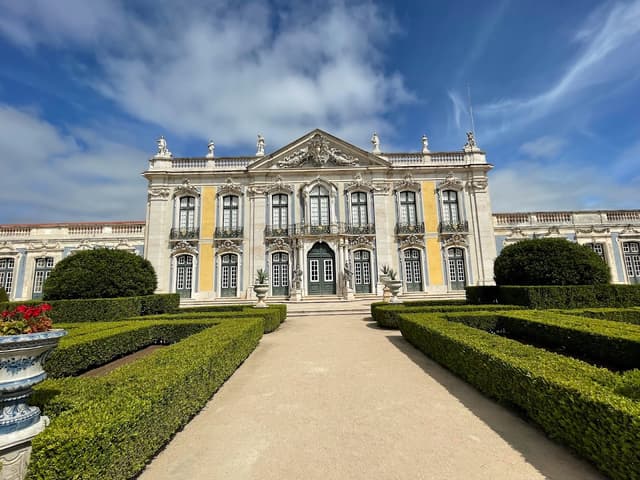
Queluz National Palace
@pedralexpereira
In 1654, João IV established the Casa do Infantado, which included the Queluz Country House, built on a commission from the first Marquis of Castelo Rodrigo, Cristóvão de Moura, and confiscated in the wake of the Restoration of Independence in 1640. The Casa do Infantado was a seigniory created for the second-born sons of the Portuguese monarchs, the princes who were destined not to be the heirs to the Crown, thus enabling them to have their own property and income. Around that time, the property was given to Prince Pedro, the first Lord of the Casa do Infantado and future King Pedro II.
In 1747, Prince Pedro, third Lord of the Casa do Infantado and future King Pedro III (on his marriage to Queen Maria I) appoints the architect Mateus de Vicente de Oliveira to expand what was then called the “Old Palace”. Years later, in 1760, the announcement of the marriage of Pedro to the heir to the throne, Princess Maria was cause for more extensive expansion works that sought to endow the property with the nobility of a royal palace. In this phase, the construction was under the supervision of the architect and goldsmith Jean-Baptiste Robillion. Removed from the politics and intrigues of the court, and in possession of both a considerable fortune and refined habits, Pedro III dedicated his attentions to this site, transforming it into a place for the leisure and recreation of the Royal Family and installing a series of reception halls, such as the Throne Room and the Ambassadors Room. In the gardens, the decoration is characterised by the series of sculptural groups evoking classical mythology, with the lead statues from the London workshop of John Cheere representing one particularly highlight.
Following the 1794 blaze that destroyed the Royal Complex of Ajuda, which had been the Royal Family’s permanent residence ever since the earthquake of 1755, the Palace of Queluz became the official resident of Queen Maria I – who was widowed in the meantime – and, subsequently, the Prince Regents João VI and Carlota Joaquina, who stipulated the adaptation of some interior spaces and the construction of new buildings to accommodate the Court, the Royal Guard and their entourage of servants. Queluz thus also became the site where the Court would go to spend their leisure time, attending serenades, horse races and firework displays.
The palace was permanently inhabited through to the departure of the Royal Family for Brazil at the time of the Napoleonic invasion in 1807, and just one day before French troops entered Lisbon under the command of General Junot. It is said that in this same year, Junot himself visited the palace and this led to the hope of his one day welcoming and installing Napoleon Bonaparte in residence there.
In 1821, King João VI returned to Portugal but the palace would only again be inhabited under a regime of semi-exile by Queen Carlota Joaquina, accused of conspiring against her husband. Furthermore, there was never any return to the golden times of this palace and never again were its halls and gardens so animated by court parties and celebrations.
The following generation, shaped by the Civil War that pitted Miguel against his brother, King Pedro IV of Portugal and first emperor of Brazil, closed the period of royal residence in the Palace of Queluz. Miguel, a defender of the absolutist cause, lived in the palace in the period he was king and during the bloody civil war in which he confronted Pedro IV, his brother who fought for the advent of constitutional liberalism. Pedro was to win the war but, on the grounds of illness, abdicated the throne of Portugal in favour of his young daughter, Maria II. It was in the Palace of Queluz, in the Don Quixote Room, where he had been born, that Pedro IV ended up passing away.
Years later, in 1910, the National Palace of Queluz was classified as a National Monument. As from 1957, the D. Maria I Pavilion, the eastern wing of the palace, began to serve the function of residence to heads of state making official visits to Portugal.
In 1979, the Portuguese School of Equestrian Art, with the purpose of fostering the teaching, practice and dissemination of traditional Portuguese Equestrian Art, opened its headquarters in the palace gardens.
Parques de Sintra took over the management of the monument in 2012 and, one year later, it became a member of the European Royal Residences Network.
Currently, the National Palace of Queluz and its historical gardens constitute one of the leading examples of the harmonious connections between landscape and palatial architecture in Portugal, which requires preserving. Parques de Sintra has undertaken a series of restoration and renovation projects of which we would highlight the interventions made to the facades, which returned the palace to its original blue colour, and the rehabilitation of the Botanical Garden, a project that in 2018 won an unprecedented two European Union Awards for Cultural Heritage / Europa Nostra Awards: in the categories of Conservation and the Public Choice Award.
The Portuguese School of Equestrian Art remains headquartered in the palace gardens. In order to foster the study of this art and the regular training of riders, in 2015, Parques de Sintra established the only national library dedicated exclusively to Equestrian Art in the National Palace of Queluz. The D. Diogo de Bragança, VIII Marquis of Marialva Equestrian Art Library contains over 1,400 works, including various rare editions and copies.

Details
Coffe and sweets
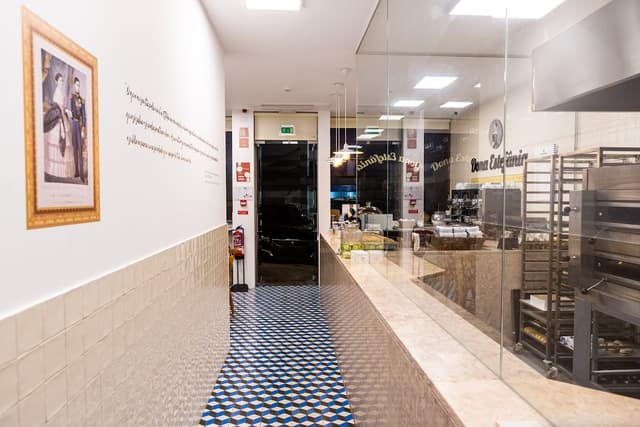
Dona Estefânia - Fábrica de Queijadas e Travesseiros de Sintra
@pedralexpereira
Hot batches of pillows and cheesecakes have been coming out for two years throughout the day at this recent factory, which is already a success story. Dona Estefânia is the new addition to local sweets in Sintra, with the name of a queen.
She is from Sintra, graduated in Health and Sports but is an example that a son of a fish knows how to swim. With parents and uncles who were pastry chefs, Pedro Gomes always grew up around cakes and ovens. “I slept on the bags of flour”, laughs the pastry chef at Dona Estefânia, the pillow and cheese factory that was founded two years ago in Sintra. The desire was already old, but it came true when he met co-founder Paulo Veríssimo. Six months later, they were opening doors.
Right at the entrance to the space, which has a room and terrace where 70 diners sit, attention turns to the open production area, where anyone can take a look at the various manufacturing processes, from the making of the bases to the output of the batches. “There are no secrets here,” says Pedro. The pillows, without the folds of puff pastry and with a reinforced dose of filling, are sold in three sizes (normal, mini and candy). Around two thousand units are made per day. As for the cheesecakes, you can try them individually, in a mini version or in a one-kilo pie. The secret of both “is in the quality of the product”, from Algarve almonds to local cow's cheese.

Details

Details

Details

Details

Details

Details

Details

Details

Details

Details
Restaurants

Details

Details

Details

Details

Details
* * *

